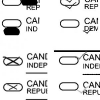494 search results - page 1 / 99 » Ballot mark detection |
ICPR
2008
IEEE
15 years 3 days ago
2008
IEEE
Optical mark sensing, i.e., detecting whether a "bubble" has been filled in, may seem straightforward. However, on US election ballots the shape, intensity, size and pos...
DRR
2009
13 years 8 months ago
2009
Analyzing paper-based election ballots requires finding all marks added to the base ballot. The position, size, shape, rotation and shade of these marks are not known a priori. Sc...
WOTE
2010
13 years 9 months ago
2010
Optical mark-sense scanning has lead to a resurgence in the use of paper ballots in the United States, despite a century of strong competition from paperless direct-recording votin...
ICDAR
2009
IEEE
13 years 8 months ago
2009
IEEE
The push toward voting via hand-marked paper ballots has focused attention on the limitations of current optical scan systems. Discrepancies between human and machine interpretati...
ICASSP
2011
IEEE
13 years 2 months ago
2011
IEEE
Marked point processes have received a great attention in the recent years, for their ability to extract objects in large data sets as those obtained in biological studies or hype...

